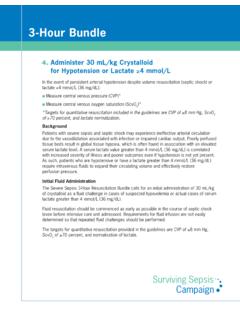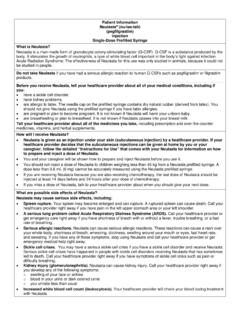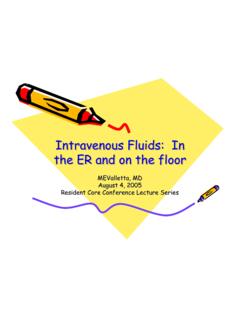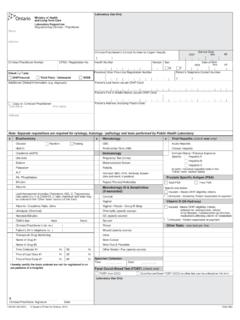Transcription of Urinalysis - HDCN
1 Chapter 1 / Urinalysis1 INTRODUCTIONThe Urinalysis (UA) is critically important in the diagnosis of renal and urologic diseases (Akin et al., 1987; Kroenke et al., 1986). Indeed, it is generally the first test that the nephrologist looks at in evaluating acute kidney injury or chronic kidney disease (CKD). It would not be inaccu-rate to state that the UA is to nephrology what the electrocardiogram (EKG) is to cardiology (Sheets & Lyman, 1986). It is usually abnormal in patients with kidney disease and may reveal abnormalities in patients without proteinuria. If proteinuria is detected, it should be quantitated by a random urine albumin/creatinine and/or protein/creatinine ratio (see below and Chapter 2).
2 There are three portions of a complete UA: the appearance of the urine, the dipstick evaluation, and the microscopic examination. With a few exceptions ( , urine samples positive for glucose or ketones give a larger proportion of false negatives for leukocytes, and patients with clinically significant crystalluria will typically have negative dipsticks), a negative dipstick obviates the need to examine the sediment (Bon-nardeaux et al., 1994; Schumann & Greenberg, 1979). However, with current automated UA techniques, both are often done in color of the urine should be assessed. The color of normal urine varies from clear (dilute) to yellow (concentrated).
3 Macroscopic (gross) hematuria will make the urine appear red. Smoky red or cola-colored urine suggests glomerulonephritis. Dark yellow to orange urine is typi-cal of bilirubinuria. Cloudy urine suggests pyuria or crystalluria (usu-ally phosphates). Milky urine suggests chyluria (lymphatic/urinary fistula). Red urine Dipstick positive for blood indicates heme is present Red blood cells (RBCs) in urine sediment hematuria No RBCs in urine sediment hemoglobinuria (hemolysis), myo-globinuria (rhabdomyolysis), lysis of RBCs in dilute and/or alka-line urine (suspect if specific gravity < and/or pH >8) Dipstick negative Porphyria Beet ingestion in susceptible patients (beeturia) Food dyes Other colors Orange rifampin, phenazopyridine (Pyridium)
4 , carotene Yellow bilirubin White pyuria, chyluria, amorphous phosphate crystals Green methylene blue, amitryptiline, propofol, asparagus, Pseu-domonas infection Black ochronosis (alkaptonuria), melanomaUrinalysis11 Chapter 1 / Urinalysis2 DIPSTICK Blood Dipstick positive for blood indicates heme is present (see above) Microscopic hematuria by definition is hematuria in the absence of a visual change in color of the urine. As few as 2 to 3 RBC/hpf may make the dipstick positive Heme pigments will make the dipstick positive in the absence of hematuria (see above) Ascorbic acid may mask true hematuria ( , false negative dipstick) pH Normal pH range is to 8 (usually 5 to 7).
5 Low urine pH (< ) High protein diet (increased endogenous acid production from sulfur-containing amino acids) Metabolic acidosis ( , chronic diarrhea) High urine pH (usually >7) Metabolic alkalosis ( , vomiting) Distal renal tubular acidosis (urine pH is > in face of acidosis) Urea-splitting organisms ( , Proteus) (urine pH often 9) Urine that is infected will become alkaline over time due to formation of ammonia (NH3) from bacterial urease Urine that is exposed to air for a long time can also have elevated pH due to loss of CO2 from the urine Specific gravity Specific gravity is the weight of urine relative to distilled water and re-flects the number and size (weight) of particles in urine.
6 Osmolality is dependent only on the number of particles (solute concentration) in urine. Specific gravity is usually directly proportional to osmolality. However, iodinated contrast and, to a lesser extent, protein, will in-crease specific gravity but have little effect on osmolality. The normal range of urine specific gravity is (very dilute) to (very con-centrated). Urine specific gravity of is the same as plasma (isos-thenuria). If specific gravity is not > after a 12-hour overnight fast ( food and water), renal concentrating ability is impaired. In an oliguric patient, a specific gravity > suggests normal ability to concentrate urine and prerenal failure (decreased renal blood flow), whereas suggests loss of tubular function (acute tubular necrosis/acute kidney injury).
7 In a hyponatremic patient, an inappropriately high specific grav-ity (> ) suggests antidiuretic hormone (ADH) secretion (see Chapter 4). In a hypernatremic patient, an inappropriately low specific gravity (< ) suggests diabetes insipidus (central or nephrogenic) (see Chapter 4). Protein The dipstick detects primarily albumin. Normal urine has no protein by dipstick, but occasionally very concentrated urine will be trace positive for protein in healthy individuals. A positive dipstick should lead to a quantitative measurement. Classically, this was done by a 24-hour collection, but as creatinine is excreted at a constant rate, a ratio of urine albumin to creatinine or protein to creatinine is suf-ficient in most patients.
8 Albumin versus total protein (Shihabi et al., 1991). Healthy subjects excrete up to 30 mg of albumin and 150 to 200 mg of total protein Chapter 1 / Urinalysis3per day (and on average 1,000 mg of creatinine per day). Thus, the normal urine albumin to creatinine ratio (UACR) is <30 mg per g and the normal urine protein to creatinine ratio (UPCR) is <150 to 200 mg per g. UACR of 30 to 300 mg per g is considered to be microalbuminuria and >300 mg per g overt albuminuria. UPCR >500 mg per g indicates overt proteinuria. Classically, sulfosalicyclic acid (SSA) was added to the urine to detect total protein.
9 A discrepancy between the dipstick and SSA test ( , 1+ protein in dipstick and 4+ by SSA) suggested the presence of a paraprotein ( , myeloma protein) in the urine. A marked discrepancy between UACR and UPCR gives the same information. Glucose Normal urine does not contain glucose due to reabsorption of filtered glucose by the proximal tubule. Glycosuria with elevated blood glucose diabetes mellitus (Singer et al., 1989) Glycosuria with normal blood glucose renal glycosuria Isolated Associated with other proximal tubular dysfunction (phospha-turia, aminoaciduria, bicarbonaturia) (Fanconi syndrome).
10 One should exclude multiple myeloma Ketones Normally, there are no ketones in the urine. Ketonuria without ketoacidosis starvation, low carbohydrate (Atkins) diet, isopropyl alcohol ingestion Ketonuria with ketoacidosis diabetic or alcoholic ketoacidosis. Note that in some patients with ketoacidosis, the dipstick may be negative due to reduction of acetoacetate to -hydroxybutyrate Bilirubin Normally there is no bilirubin in the urine. If present, this suggests any of the following: Hepatobiliary disease ( failure to conjugate and/or excrete biliru-bin into the gut) Hemolysis (increased production of bilirubin from heme) Urobilinogen Bilirubin is secreted in bile into the gut, where it is metabolized by microorganisms into urobilinogen.






